Exploration of Pluto
The exploration of Pluto began with the arrival of the New Horizons probe in July 2015, though proposals for such a mission had been studied for many decades.[1] There are no plans as yet for a follow-up mission, though follow-up concepts have been studied.[2][3]

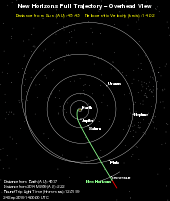
Early mission proposals
Exploring Pluto was contemplated since its discovery by Clyde Tombaugh in 1930, but Pluto presents significant challenges for exploration because of its small mass and great distance from Earth. The two probes of the Voyager program, launched in 1977 to explore Jupiter and Saturn, had also the ability for an extended mission to other targets. Pluto was rejected in favor of Titan, Uranus and Neptune.
One of many possibilities for the Voyager 1 spacecraft after its flyby of Saturn in 1980 was to use Saturn as a slingshot towards Pluto for a flyby as early as March 1986.[4][5] However, scientists decided that a flyby of Titan during the Saturn encounter would be a more important scientific objective. A subsequent flyby of Pluto was impossible, because the close approach of Titan meant it was also on a trajectory that slingshotted it upwards out of the ecliptic.[6] Because no mission to Pluto was planned by any space agency at the time, it would be left unexplored by interplanetary spacecraft for years to come.
Shortly after Voyager 2's flyby of Neptune and its findings at Triton in August 1989, scientists sought interest in a mission to Pluto and further studies for the existence of a Kuiper belt and Kuiper belt objects, potentially similar to Triton.[7] All four outer planets were explored by Voyager 2, launched in 1977, with close approaches to Jupiter, Saturn, Uranus, and Neptune. After a Neptune encounter, the alignment of Pluto made it impossible for Voyager 2 to continue there, leaving it on a trajectory out of the Solar System.
The two Voyager missions had the success criteria of just one of them reaching Saturn, which they far exceeded. After Voyager 2 successfully returned data from Neptune in 1989, planetary scientists looked to Pluto as the destination for a subsequent mission. In 1992, NASA's Jet Propulsion Laboratory (JPL) proposed the Pluto Fast Flyby mission. This became known as the Pluto Express, and eventually the Pluto-Kuiper Express. This project got delayed, and in 2000 the mission was cancelled, with NASA giving the reason of cost overruns.
The cancellation of Pluto Kuiper Express angered some of the space-exploration scientific community, which led to groups, such as The Planetary Society, lobbying NASA for either a reboot of the Pluto Kuiper Express or a restart of a mission to Pluto. Internal divisions within NASA, including its Scientific Advisory Council, also voiced support for a Pluto mission.[8] In response to the backlash caused by the cancellation of Pluto Kuiper Express, it was decided to inaugurate a new class of missions that would fit between the big-budget Flagship Program and the low-budget Discovery Program, creating a compromise for missions such as the former Pluto Kuiper Express, which proved to be too expensive for the Discovery Program. A competition was held, in which NASA would select a mission concept to fund as part of the first mission of the New Frontiers program.[9]
The Pluto Underground, Pluto 350 and Mariner Mark II

In May 1989, a group of scientists and engineers, including Alan Stern and Fran Bagenal, formed an alliance called the "Pluto Underground". It was named in homage of the Mars Underground, another group of scientists that successfully lobbied for the restart of missions to Mars, following the lack of such since the Viking program. The group started a letter writing campaign which aimed to bring to attention Pluto as a viable target for exploration.[10] In 1990, because of pressure from the scientific community, including those of the Pluto Underground, engineers at NASA decided to look into concepts for a mission to Pluto. At the time, it was thought that the atmosphere of Pluto would freeze and fall to the surface during winter, and so a lightweight spacecraft was desirable, as it would be able to reach Pluto before such an event would occur. One of the earliest concepts was for a 40-kilogram spacecraft that would reach Pluto in five to six years. The idea was shortly scrapped, however, because of the infeasibility of miniaturizing scientific instruments aboard such a spacecraft to that size.[8]
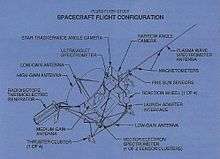
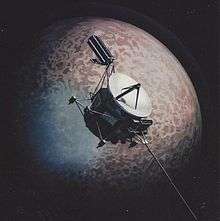
Another mission concept, known as Pluto 350, was developed by Robert Farquhar of the Goddard Space Flight Center, with Alan Stern and Fran Bagenal of the Pluto Underground, who both served as study scientists for the project. Pluto 350 aimed to send a spacecraft, weighing 350 kilograms, to Pluto.[7] The spacecraft's minimalistic design was to allow it to travel faster and be more cost-effective, in contrast to most other big-budget projects NASA were developing at the time, such as Galileo and Cassini. Pluto 350, however, would later become controversial among mission planners at NASA, who considered the project to be too small and too high-risk. An alternative plan which was considered at one point was to send to Pluto a configuration of the Mariner Mark II spacecraft, which would weigh 2,000 kilograms and cost US$3.2 billion, in sharp contrast to Pluto 350's $543 million cost.[8] While both projects competed for approval, Pluto 350 was more favored by NASA mission planners, who were starting to adopt smaller missions such as Mars Pathfinder and NEAR Shoemaker.[7]
USPS postage stamp and "Pluto Fast Flyby"
S. Alan Stern on the USPS stamp[8]
In October 1991, the United States Postal Service released a series of stamps commemorating NASA's exploration of the Solar System.[11] The series featured a stamp for all planets, displaying an image of the planet and highlighting an associated spacecraft which was sent to it. The stamp for Pluto, however, depicted a featureless sphere, presented with the phrase "not yet explored" in place of the name of a spacecraft. The stamps were unveiled in a ceremony at the Jet Propulsion Laboratory. Two scientists who attended the event, World Space Foundation president Robert Staehle and JPL scientist Stacy Weinstein, were inspired by Pluto's status on the stamp, such that they started to inquire about the feasibility of sending a spacecraft to Pluto.[12][13] Engineers at the Jet Propulsion Laboratory, inspired by the "Not Yet Explored" status of Pluto, also started to put forward ideas about a mission to Pluto.[14][15]
In August 1992, Staehle telephoned Pluto's discoverer, Clyde Tombaugh, requesting permission to visit his planet. "I told him he was welcome to it", Tombaugh later remembered, "though he's got to go one long, cold trip".[16] That year, Staehle, with the help of JPL engineers and students from the California Institute of Technology, formed the Pluto Fast Flyby project. The mission heralded the same ideology as the Pluto 350 concept: small in size and cost-effective in scope, so that the spacecraft would be able to get to Pluto faster and be affordable to develop and launch. Described as a "radical" mission concept, the mission would see two spacecraft being sent to Pluto. Both spacecraft were to weigh only around 35-50 kilograms each (including 7 kg worth of scientific instruments), and the project would cost less than US$500 million to develop, excluding launch costs.[12] Described by Staehle as a "faster, better, [and] cheaper" approach than the Pluto 350 and Mariner Mark II projects, it caught the attention of then-NASA Administrator Daniel S. Goldin, who ordered all work on both Pluto 350 and Mariner Mark II to cease and shift all resources to the new Pluto Fast Flyby project instead.[7]
During the development of Pluto Fast Flyby, however, there were multiple concerns from both NASA, Administrator Goldin and the mission's development team. As research and development into the mission progressed, the project's size, scope, and budget all expanded. Additionally, morale among the team and personnel working on interplanetary missions was low following the loss of the Mars Observer spacecraft during its attempted Areocentric orbit insertion in August 1993. Alan Stern would later cite that event as a significant factor towards the low enthusiasm for the Pluto Fast Flyby project.[8] The spacecraft were intended to be launched using Titan IV rockets, which would have cost US$400 million each, thus raising the budget to over US$1 billion.[7] Because of growing budget constraints, the dual-spacecraft concept was scrapped in favor of sending a single spacecraft to Pluto. The project was still too expensive, however, in the eyes of Administrator Goldin.[8] Alan Stern, as a compromise, reached an agreement with Russian Space Research Institute scientists in Moscow, in which Pluto Fast Flyby would be launched atop a Proton rocket, saving NASA over US$400 million in launch costs. Alec Galeev, head of the Russian Space Research Institute, reached the agreement with Stern by stipulating that Russia would include an atmospheric probe that would impact Pluto after studying its atmosphere with a mass spectrometer.[17] The proposal was forwarded to Administrator Goldin, but he vetoed the proposal, recommending instead that the JPL look into the feasibility of Pluto Fast Flyby being launched aboard a smaller rocket, such as the Delta II.[7]
Kuiper belt, Pluto Kuiper Express and cancellation
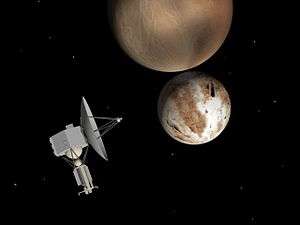
During the course of the late 1990s, a number of Trans-Neptunian objects were discovered, confirming the existence of a Kuiper belt. Interest in a mission to the Kuiper belt arose such that NASA instructed the JPL to re-purpose the mission as not only a Pluto flyby, but also a Kuiper belt object (KBO) flyby. The mission was thus re-branded as the Pluto Kuiper Express, after briefly being billed as Pluto Express prior to the revision. The weight of the spacecraft was raised again, this time to 175 kilograms, and NASA allowed further liberty with the project's budget.[7]
However, Goldin later decided that Pluto Kuiper Express was of low importance, and thus cut funding to the project drastically. Eventually, despite official selection of scientific instruments and the appointment of several investigators, then-Science Mission Directorate Edward J. Weiler ordered the cancellation of the entire Pluto and Kuiper belt mission in 2000, citing growing budget constraints, which had plagued the project since its inception in 1992. At the time of cancellation, the projected costs surpassed $1 billion.[8][9]
Proposed exploration (2003)
A Pluto orbiter/lander/sample return mission was proposed in 2003. The plan included a twelve-year trip from Earth to Pluto, mapping from orbit, multiple landings, a warm water probe, and possible in situ propellant production for another twelve-year trip back to Earth with samples. Power and propulsion would come from the bimodal MITEE nuclear reactor system.[18]
A full list of previous and upcoming missions to the outer Solar System can be found at the List of missions to the outer planets article.
New Horizons
After an intense political battle, a revised mission to Pluto called New Horizons was granted funding from the US government in 2003.[19] New Horizons was launched successfully on 19 January 2006. The mission leader, S. Alan Stern, confirmed that some of the ashes of Clyde Tombaugh, who died in 1997, had been placed aboard the spacecraft.[20]

New Horizons captured its first (distant) images of Pluto in late September 2006, during a test of the Long Range Reconnaissance Imager.[21] The images, taken from a distance of approximately 4.2 billion kilometers, confirmed the spacecraft's ability to track distant targets, critical for maneuvering toward Pluto and other Kuiper belt objects. In early 2007 the craft made use of a gravity assist from Jupiter.
On 4 February 2015, NASA released new images of Pluto (taken on 25 and 27 January) from the approaching probe.[22] New Horizons was more than 203,000,000 km (126,000,000 mi) away from Pluto when it began taking the photos, which showed Pluto and its largest moon, Charon. On 20 March 2015, NASA invited the general public to suggest names for surface features that will be discovered on Pluto and Charon.[23] On 15 April 2015, Pluto was imaged showing a possible polar cap.[24] Between April and June 2015, New Horizons began returning images of Pluto that exceeded the quality that the Hubble Space Telescope could produce.[25][26]
Pluto's small moons, discovered shortly before and after the probe's launch, were considered to be potentially hazardous, as debris from collisions between them and other Kuiper belt objects could have produced a tenuous dusty ring. If New Horizons had travelled through such a ring system, there would have been an increased risk of potentially disabling micrometeoroid damage.[27]
New Horizons had its closest approach to Pluto on 14 July 2015—after a 3,462-day journey across the Solar System. Scientific observations of Pluto began five months before the closest approach and continued for at least a month after the encounter. New Horizons used a remote sensing package that includes imaging instruments and a radio science investigation tool, as well as spectroscopic and other experiments, to characterize the global geology and morphology of Pluto and its moon Charon, map their surface composition and analyze Pluto's neutral atmosphere and its escape rate. New Horizons also photographed the surfaces of Pluto and Charon.
Photographs of Pluto taken on 14 July 2015 taken 15 minutes after New Horizon's closest approach, from a distance of 18,000 kilometers and sent to Earth on 13 September 2015 show a near-sunset on Pluto with details of the surface and a haze in the atmosphere.[28][29]
Future mission concepts
No follow-up missions to New Horizons have been formally planned, but at least two mission concepts have been studied. In April 2017, a workshop met in Houston, Texas to discuss ideas for a follow-up mission.[30] Possible objectives discussed by the group for a follow-up mission include mapping the surface at 30 feet per pixel, observations of Pluto's smaller satellites, observations of how Pluto changes as it rotates on its axis, and topographic mapping of Pluto's regions that are covered in long-term darkness due to its axial tilt. The last objective could be accomplished using infrared laser pulses. According to New Horizons principal investigator Alan Stern, “If we send an orbiter, we can map 100 percent of the planet, even terrains that are in total shadow." [30] Stern and David Grinspoon have also suggested that an orbiter mission could search for evidence of the subsurface ocean hinted at in New Horizons data.[31]
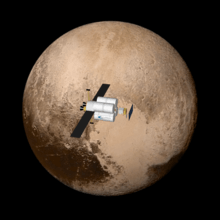
Shortly after the New Horizons flyby, Stern suggested a Charon lander as a follow-up that would observe Pluto from Charon's surface.[32] However, such a lander would only observe the Charon-facing hemisphere of Pluto, as Pluto and Charon are tidally locked. Since the Houston workshop, Stern changed his mind to advocate instead for a Cassini-style orbiter that would use Charon's gravity to adjust its orbit while studying Pluto and its moons.[32] The probe could use electric propulsion similar to NASA's Dawn mission. It would then have the option of using Charon's gravity to leave the Pluto system after all Pluto science objectives are completed and study new KBOs beyond Pluto. Stern envisaged the probe being launched in 2030, marking the 100th anniversary of Pluto's discovery, and spending 7-8 years traveling to the Pluto system.
Fusion-Enabled Pluto Orbiter and Lander
The Fusion-Enabled Pluto Orbiter and Lander was a 2017 phase I report funded by the NASA Innovative Advanced Concepts (NIAC) program.[3][33] The report, written by principal investigator Stephanie Thomas of Princeton Satellite Systems, Inc., describes a Direct Fusion Drive (DFD) mission to Pluto. A fusion reactor would be used to send a 1000 kg orbiter and lander to the Pluto system in only four years (more than twice as fast as New Horizons).[34]
Pluto Hop, Skip, and Jump
Global Aerospace Corporation presented a Pluto lander concept titled "Pluto Hop, Skip, and Jump" at the 2017 NIAC Symposium in Denver, Colorado.[35][2] The concept describes an entrycraft that would brake using the drag of Pluto's thin but highly spread-out atmosphere. Once on Pluto's surface, the vehicle would exploit Pluto's low gravity to hop between sites using propellant. This is similar to NASA's Triton Hopper concept for exploring Neptune's largest moon Triton.
References
- Chang, Kenneth (18 July 2015). "The Long, Strange Trip to Pluto, and How NASA Nearly Missed It". The New York Times. Retrieved 19 July 2015.
- "Global Aerospace Corporation to present Pluto lander concept to NASA". EurekAlert!. Retrieved 8 July 2018.
- Hall, Loura (5 April 2017). "Fusion-Enabled Pluto Orbiter and Lander". NASA. Retrieved 8 July 2018.
- Betz, Eric (23 June 2015). "Why didn't Voyager visit Pluto?". Astronomy. Kalmbach Publishing. Retrieved 8 July 2015.
- "Voyager Frequently Asked Questions". Jet Propulsion Laboratory. 14 January 2003. Archived from the original on 21 July 2011. Retrieved 8 September 2006.
- Landau, Elizabeth R.; Medina, Enrique; Angrum, Andrea. "Frequently Asked Questions". Voyager. Jet Propulsion Laboratory (JPL) / National Aeronautics and Space Administration (NASA). Archived from the original on 21 July 2011. Retrieved 8 July 2015. "Voyager 1 could have been aimed on to Pluto, but exploration of Titan, because of it being the only known moon to have a significant atmosphere (determined by Gerard Kuiper in 1944 to be methane), and the rings of Saturn was a primary scientific objective. This caused the trajectory to be diverted upward out of the ecliptic plane such that no further planetary encounters were possible for Voyager 1."
- Stern, Alan; Christopher, Russell (2009). New Horizons: Reconnaissance of the Pluto-Charon System and the Kuiper Belt. Springer Science+Business Media. pp. 6, 7. ISBN 978-0-387-89518-5. Retrieved 8 July 2015.
- Davis, Jason (7 July 2015). "Pushing Back the Frontier: How The Planetary Society Helped Send a Spacecraft to Pluto". The Planetary Society. Retrieved 8 July 2015.
- Hand, Eric (25 June 2015). "Feature: How Alan Stern's tenacity, drive, and command got a NASA spacecraft to Pluto". Science. American Association for the Advancement of Science. Retrieved 8 July 2015.
- Betz, Eric (24 June 2015). "How'd we get New Horizons? You can thank the Pluto Underground". Astronomy. Kalmbach Publishing. Retrieved 8 July 2015.
- Smithsonian National Postal Museum (date unknown). Space Exploration Issue - 29c Pluto single - Scott Catalogue USA: 2577. Retrieved from http://arago.si.edu/index.asp?con=2&cmd=1&id=192129&img=1&pg=1.
- Foust, Jeff (23 January 2006). "A Journey's Ending and Beginning". The Space Review. SpaceNews. Retrieved 8 July 2015.
- Betz, Eric (26 June 2015). "Postage for Pluto: A 29-cent stamp pissed off scientists so much they tacked it to New Horizons". Astronomy. Kalmbach Publishing. Retrieved 8 July 2015.
- "'Not Yet Explored' no more: New Horizons flying Pluto stamp to dwarf planet". collectSPACE. Robert Pearlman. 7 July 2015. Retrieved 8 July 2015.
- Staehle, Robert L.; Terrile, Richard J.; Weinstein, Stacy S. (1 October 1994). "To Pluto by way of a postage stamp". The Planetary Report. 14 (5): 4–11. Bibcode:1994PlR....14e...4S. Retrieved 8 July 2015.
- Sobel, Dava (1993). "The last world". Discover magazine. Retrieved 13 April 2007.
- Stern; Grinspoon, Alan; David (2018). Chasing New Horizons: Inside the Epic First Mission to Pluto. New York: Picador. p. 57.
- Powell, James; Maise, George; Paniagua, John (8–15 March 2003). Pluto Orbiter/lander/sample return missions using the MITEE nuclear engine. 2003 IEEE Aerospace Conference. Ieeexplore.ieee.org. doi:10.1109/AERO.2003.1235077. ISBN 978-0-7803-7651-9.
- Britt, Robert Roy (2003). "Pluto Mission a Go! Initial Funding Secured". space.com. Archived from the original on 23 August 2010. Retrieved 13 April 2007.
- Stern, S. Alan (2006). "Happy 100th Birthday, Clyde Tombaugh". Southwest Research Institute. Archived from the original on 15 April 2007. Retrieved 13 April 2007.
- "New Horizons, Not Quite to Jupiter, Makes First Pluto Sighting". pluto.jhuapl.edu – NASA New Horizons mission site. Johns Hopkins University Applied Physics Laboratory. 28 November 2006. Archived from the original on 9 March 2011. Retrieved 29 November 2011.
- "Happy Birthday Clyde Tombaugh: New Horizons Returns New Images of Pluto". pluto.jhuapl.edu – NASA New Horizons mission site. Johns Hopkins University Applied Physics Laboratory. 4 February 2015. Retrieved 14 July 2015.
- "Help us put names on the maps of Pluto and Charon!". Archived from the original on 23 April 2016. Retrieved 19 July 2015.
- Brown, Dwayne; Buckley, Michael (29 April 2015). "NASA's New Horizons Detects Surface Features, Possible Polar Cap on Pluto". National Aeronautics and Space Administration. Retrieved 30 April 2015.
- NASA (2015). "Timeline". New Horizons News Center, Johns Hopkins Applied Physics Laboratory. Retrieved 14 July 2015.
- Morring, Jr., Frank (29 April 2015). "New Horizons Delivering Pluto Imagery With Better Resolution Than Hubble". aviationweek.com. Retrieved 14 July 2015.
- Steffl, Andrew J.; Stern, S. Alan (2007). "First Constraints on Rings in the Pluto System". The Astronomical Journal. 133 (4): 1485–1489. arXiv:astro-ph/0608036. Bibcode:2007AJ....133.1485S. doi:10.1086/511770.
- "Sunset on Pluto [Slide Show]". Retrieved 17 September 2015.
- "Pluto 'Wows' in Spectacular New Backlit Panorama". Retrieved 18 September 2015.
- "Why a group of scientists think we need another mission to Pluto". The Verge. Retrieved 8 July 2018.
- Stern, Alan; Grinspoon, David (2018). Chasing New Horizons: Inside the Epic First Mission to Pluto. New York: Picador. p. 279. ISBN 978-1250098962.
- "Going Back to Pluto? Scientists to Push for Orbiter Mission". Space.com. Retrieved 14 July 2018.
- Hall, Loura (7 April 2016). "Fusion-Enabled Pluto Orbiter and Lander". NASA. Retrieved 8 July 2018.
- The next Pluto mission—an orbiter and lander?. Nancy Atkinson, PhysOrg. 27 April 2017.
- "Pluto lander concept unveiled by Global Aerospace Corporation - SpaceFlight Insider". www.spaceflightinsider.com. Retrieved 8 July 2018.

